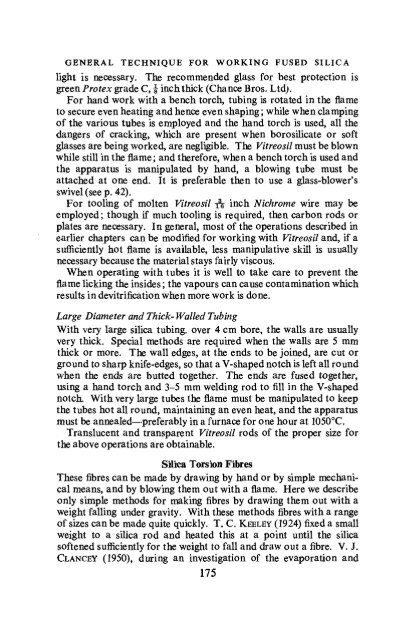Laboratory Glass-Working for Scientists - Sciencemadness Dot Org
Laboratory Glass-Working for Scientists - Sciencemadness Dot Org
Laboratory Glass-Working for Scientists - Sciencemadness Dot Org
Create successful ePaper yourself
Turn your PDF publications into a flip-book with our unique Google optimized e-Paper software.
GENERAL TECHNIQUE FOR WORKING FUSED SILICA<br />
light is necessary. The recommended glass <strong>for</strong> best protection is<br />
green Protex grade C, f inch thick (Chance Bros. Ltd).<br />
For hand work with a bench torch, tubing is rotated in the flame<br />
to secure even heating and hence even shaping; while when clamping<br />
of the various tubes is employed and the hand torch is used, all the<br />
dangers of cracking, which are present when borosilicate or soft<br />
glasses are being worked, are negligible. The Vitreosil must be blown<br />
while still in the flame; and there<strong>for</strong>e, when a bench torch is used and<br />
the apparatus is manipulated by hand, a blowing tube must be<br />
attached at one end. It is preferable then to use a glass-blower's<br />
swivel (see p. 42).<br />
For tooling of molten Vitreosil TS inch Nichrome wire may be<br />
employed; though if much tooling is required, then carbon rods or<br />
plates are necessary. In general, most of the operations described in<br />
earlier chapters can be modified <strong>for</strong> working with Vitreosil and, if a<br />
sufficiently hot flame is available, less manipulative skill is usually<br />
necessary because the material stays fairly viscous.<br />
When operating with tubes it is well to take care to prevent the<br />
flame licking the insides; the vapours can cause contamination which<br />
results in devitrification when more work is done.<br />
Large Diameter and Thick- Walled Tubing<br />
With very large silica tubing, over 4 cm bore, the walls are usually<br />
very thick. Special methods are required when the walls are 5 mm<br />
thick or more. The wall edges, at the ends to be joined, are cut or<br />
ground to sharp knife-edges, so that a V-shaped notch is left all round<br />
when the ends are butted together. The ends are fused together,<br />
using a hand torch and 3-5 mm welding rod to fill in the V-shaped<br />
notch. With very large tubes the flame must be manipulated to keep<br />
the tubes hot all round, maintaining an even heat, and the apparatus<br />
must be annealed—preferably in a furnace <strong>for</strong> one hour at 1050°C.<br />
Translucent and transparent Vitreosil rods of the proper size <strong>for</strong><br />
the above operations are obtainable.<br />
Silica Torsion Fibres<br />
These fibres can be made by drawing by hand or by simple mechanical<br />
means, and by blowing them out with a flame. Here we describe<br />
only simple methods <strong>for</strong> making fibres by drawing them out with a<br />
weight falling under gravity. With these methods fibres with a range<br />
of sizes can be made quite quickly. T. C. KEELEY (1924) fixed a small<br />
weight to a silica rod and heated this at a point until the silica<br />
softened sufficiently <strong>for</strong> the weight to fall and draw out a fibre. V. J.<br />
CLANCEY (1950), during an investigation of the evaporation and<br />
175
















